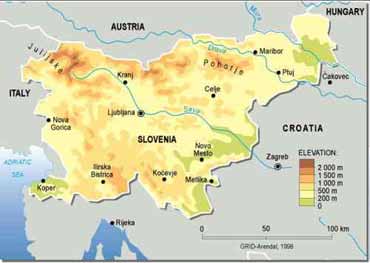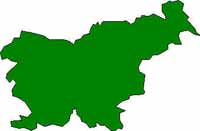SLOVENIA (general): |
Stretch
this page to fill the whole screen Back to the main page |

-Environment- -Culture- -Activities-
-Money- -Getting Around- -Sights
to visit-
Full country name: Republic of Slovenia (Republika Slovenija)
Area: 20,256 sq km (7898 sq mi)
Population: 2 million
Capital city: Ljubljana (pop 330,000)
People: Slovenian 88%, Serbo-Croatian 7%
Language: Slovene, Croatian, Serbian, German, English, Italian
Religion: Roman Catholic (72%), atheist (4.3%), Eastern Orthodox
Christian (2.4%), Muslim (1%), Protestant (1%)
Government: parliamentary democratic republic
President: Janez Drnovsek
Prime Minister: Tone Rop
Independence: June 25, 1991
Climate: Submediterranean W, subcontinental E
Landscape: Very diverse, mountainous, 54% is forest
Currency: Tolar (SIT)
GDP: US$20 billion
GDP per head: US$10,300
Annual growth: 3.5%
Inflation: 8%
Major industries: Textiles, manufacturing, timber products,
agriculture
Major trading partners: EU (esp. Germany, Croatia, Italy, France,
Austria)
Slovenia, a green and diverse country that lies between the
Alps, the Mediterranean, and the Pannonian plain, embraces all the beauties
of the Old Continent. In the eyes of many a Yugoslavian despot, Slovenia is
the golden goose that got away. Rich in resources, naturally good looking and
persistently peaceful, Slovenia has been doing just fine (flourishing, even)
since breaking away from its Yugoslav owners in 1991
Little Slovenia (Slovenija) straddles Eastern and Western Europe. Many of its
cities and towns bear the imprint of the Habsburg Empire and the Venetian Republic,
while up in the Julian Alps you'd almost think you were in Bavaria. The 2 million
Slovenes were economically the most well off among the peoples of what was once
Yugoslavia, and the relative affluence of this country on the 'sunny side of
the Alps' is immediately apparent.
Except for a brief period in June and July 1991 when Yugoslavia attempted to
stop its smallest child from leaving its collapsing nest, there's been no fighting,
no war and no terrorism in Slovenia.
Slovenia is also called the mother hen, because of its hen like shape:

-Back to top-
Slovenia occupies about 2% of central Europe - 20,256 sq km
(7817 sq mi) of land area - and it's about the size of Israel or Wales. To the
north is Austria and to the south Croatia. Shorter borders separate Slovenia
from Italy in the west and Hungary in the east. Slovenia is predominantly hilly
with more than 90% of its surface over 300m (984ft) above sea level. Forest
covers almost half of the country (making Slovenia one of the world's 'greenest'
countries) and agricultural land - mostly made up of fields, orchards, vineyards
and pastures - covers a further 43%.
There are six main regions within the country: the Alps; the pre-Alpine hills;
the Dinaric karst (a limestone region of caves and underground rivers) below
the hills; the Slovenian littoral, 47km (29mi) of Adriatic coastline; the flat
Pannonian plain; and the lowlands, making up around one-fifth of the country
mostly in the east and north-east. The interior is drained by rivers including
the Sava and the Drava (which empty into the Danube), the Soca flowing into
the Adriatic, the Mura and the Krka. The Kolpa River marks much of the border
with Croatia.
The country is home to 2900 plant species and many are unique to Slovenia. Triglav
National Park is especially rich in endemic flowering plants. Common European
animals are abundant in Slovenia, including deer, boar, chamois, bear and lynx
(all of which are hunted), and it's also home to rarer beasts such as the moor
tortoise, cave hedgehog, scarab beetle and various dormice. Proteus anguinus,
the 'human fish', is unique to Slovenia's karst caves, and is one of the world's
most mysterious creatures.
The northwest has an Alpine climate and temperatures in the Alpine valleys are
moderate in summer but cold in winter. The Adriatic coast and much of the Primorska
(westernmost) province have a Mediterranean climate with warm, sunny days and
mild winters. Most of eastern Slovenia has a Continental climate with hot summers
and cold winters. January is the coldest month when the average daytime temperature
is minus 2°C, (28°F) and July is the warmest with an average of 21°C
(70°F).
-Back to top-
Slovenian alphabet has 25 characters:
A B C C1 D E F G H I J K L M N O P R S S1 T U V Z Z1
Three letters which carry a diacritic (a caron) are not contained in the standard
ISO-8859-1 (ISO Latin 1) character set . ISO-8859-ISO Latin 2 does, but it is
not commonly used outside of Europe.
C1 stands for letter ![]() (c with a caron - pronounced as 'ch' in 'chop';)
(c with a caron - pronounced as 'ch' in 'chop';)
S1 stands for letter ![]() (s with a caron - pronounced as 'sh' in 'shall';)
(s with a caron - pronounced as 'sh' in 'shall';)
Z1 stands for letter ![]() (z with a caron - pronounced as 'su' in 'measure'';)
(z with a caron - pronounced as 'su' in 'measure'';)
Slovene is a South Slavic language written in the Roman alphabet.
It's closely related to Croatian and Serbian, but the languages are not mutually
intelligible. Slovene is grammatically complex, with lots of cases, genders
and tenses. Fortunately for non-Slovenian speakers, virtually everyone in Slovenia
speaks another language: usually Croatian, Serbian, English, German and/or Italian
(in that order). English is the preferred language of the young.
Slovenia's most beloved writer is the Romantic poet France Preseren (1800-49),
whose lyric poems set new standards for Slovenian literature and helped raise
national consciousness. Postmodernist painting and sculpture has been dominated
since the 1980s by the multimedia group Neue Slowenische Kunst (NSK) and the
five-member anonymous artists' cooperative IRWIN. Many notable buildings and
public squares in Slovenia were designed by architect Joze Plecnik (1872-1957),
whose image adorns the 500 SIT note.
Slovenian cuisine, which traditionally relies heavily on venison and fish, is
heavily influenced by that of its neighbours. From Austria, it's klobasa (sausage),
zavitek (strudel) and Dunajski zrezek (Wiener schnitzel). Njoki (potato dumplings),
rizota (risotto) and the ravioli-like zlikrofi are Italian. Hungary has contributed
golaz (goulash) and paprikas (chicken or beef stew). And then there's an old
Balkan standby, burek, a greasy layered cheese, meat or even apple pie served
at takeaway places. There are many types of dumplings; cheese ones called struklji
are the most popular. Traditional dishes are best tried at an inn (gostilna).
Slovenia produces some noticeable red and white wines, a strong brandy called
zganje and Union and Zlatorog brand beers, which are very popular.
-Back to top-
Skiing is by far the most popular sport in Slovenia, and every
fourth Slovene is an active skier. There are well-equipped ski resorts in the
Julian Alps, especially at Vogel, which has impressive ski runs overlooking
the Bohinj Valley. Well known and visited resorts are also: Krvavec, Cerkno,
Kranjska Gora, Mariborsko Pohorje... The ski season lasts from December to March.
Hiking is almost as popular as skiing. There are 7000km (4340mi) of marked hiking
trails and 165 mountain huts - which is quite considerable for such a small
country. The full grandeur of the Julian Alps can be experienced in Triglav
National Park at Bohinj. Veteran mountaineers should tramp the Slovenian Alpine
Trail, which crosses all the highest peaks in the country.
There's excellent rough and tumble white-water rafting on the Soca River; the
town of Bovec makes a good starting point. The uncrowded roads around Bled,
Bohinj and Otocec beg to be bicycled.
-Back to top-
1 EUR = 233 SIT, 1 SEK = 25 SIT
Slovenia's still much cheaper than neighbouring Italy or Austria, though prices
are increasing. It's simple to change cash and travellers cheques at banks,
post offices, travel agencies and any menjalnica, the private exchange offices.
Exchange rates can vary. Banks take a commission of 1%, while tourist offices,
travel agencies, exchange bureaus and hotels take up to 5%.
All major credit cards(VISA, Mastercard) are accepted at ATM's and most stores,
restaurants and hotels. Credit card holders can get cash advances in tolars
from banks.
A value-added tax (replacing the 'circulation' tax) is now added to the purchase
price of most goods and services. Many hotels in Slovenia levy a 'tourist tax'
on overnight visitors of about US$2. Tipping is not compulsory, but no one will
chase you out of the restaurant for leaving a 10% gratuity.
-Back to top-
Except for long journeys, bus is the preferred way of getting
around Slovenia. There are frequent departures and the network has an octopus'
reach across the country. In some cases, there's no choice; travelling by bus
is the only practical way to get to Bled and Bohinj, the Julian Alps and much
of the coast from Ljubljana. You might need to make a reservation on Friday
afternoons, when many students leave Ljubljana for the weekend. With the exception
of the new ICS express train between Ljubljana and Maribor, travel by rail is
best left to sightseers: one of the prettiest rides chugs through the Soca Valley.
Driving a car can be a good way to get to some of the most beautiful and isolated
towns and villages in Slovenia, and rental prices are reasonable. Rental agencies
at Brnik Airport and in Ljubljana have the most competitive rates. The country's
tolls and petrol prices are relatively inexpensive. Slovenians drive on the
right.
-Back to top-